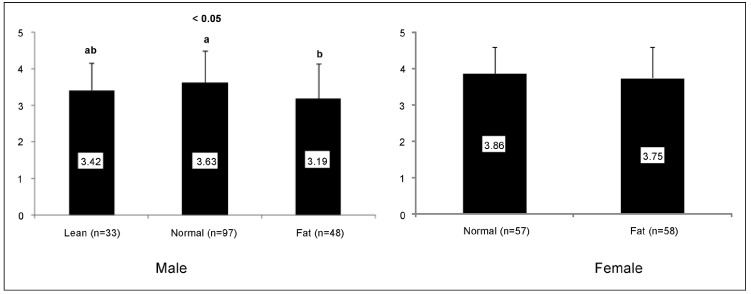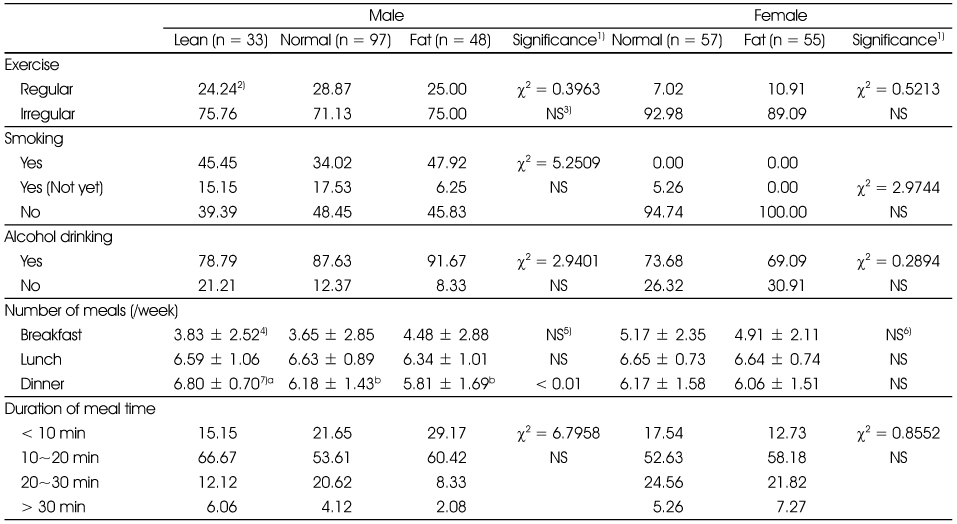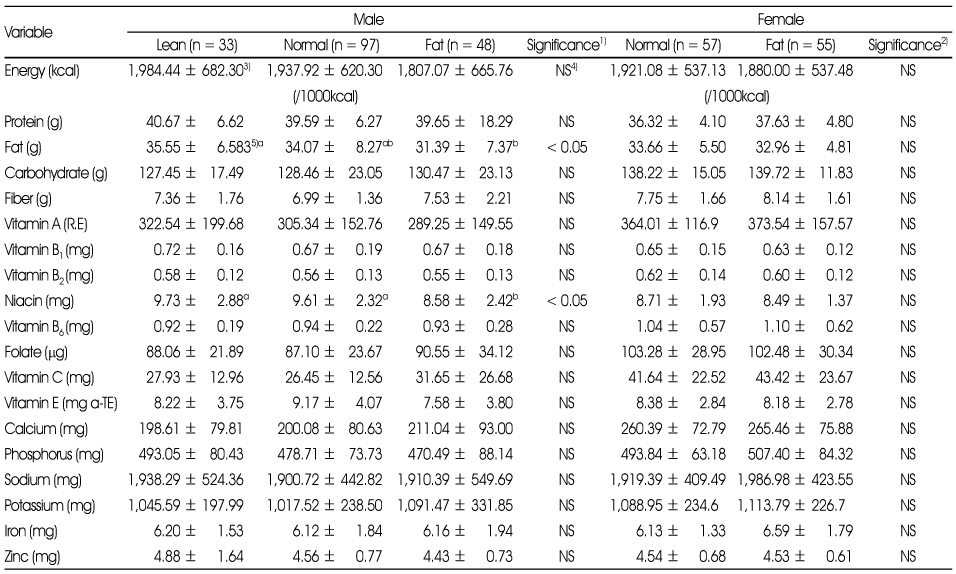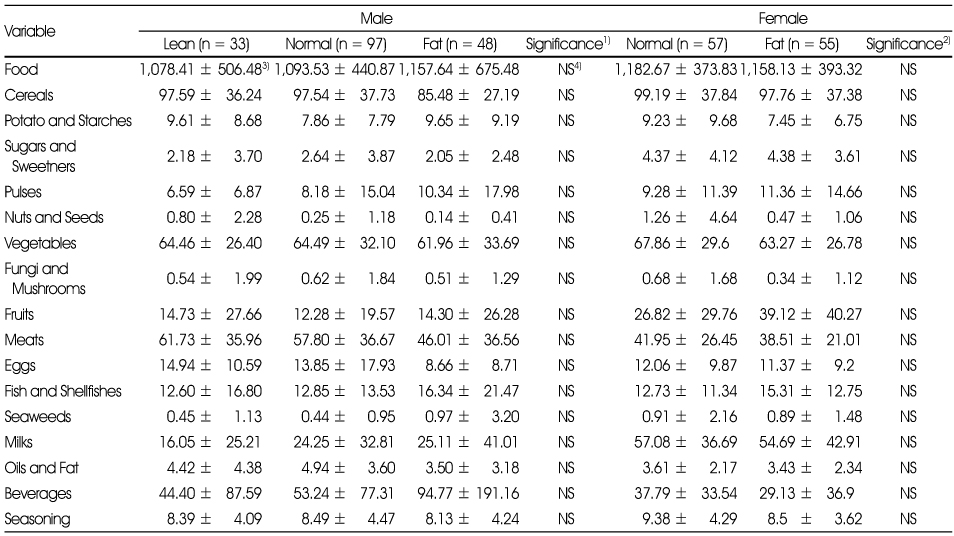Articles
- Page Path
- HOME > Korean J Community Nutr > Volume 17(5); 2012 > Article
-
Original Article
- A Study on Nutritional Status and Dietary Quality of University Students by Body Image
- Jee-Young Yeon, Seung-Hee Hong, Yun-Jung Bae
-
Korean Journal of Community Nutrition 2012;17(5):543-554.
DOI: https://doi.org/10.5720/kjcn.2012.17.5.543
Published online: October 31, 2012
Nutrition Policy Division, Nutrition Policy Office, Korea Food and Drug Administration, Chungcheongbuk-do, Korea.
1Department of Food and Nutritional Sciences, Hanbuk University, Gyeonggi-do, Korea.
- Corresponding author: Yun-Jung Bae, Department of Food and Nutritional Sceiences Hanbuk University, 233-1 Sangpae-dong, Dongducheon-si, Gyeonggi-do 483-777, Korea. Tel: (031) 860-1445, Fax: (031) 860-1449, byj@hanbuk.ac.kr
Copyright © 2012 The Korean Society of Community Nutrition
- 1,124 Views
- 5 Download
- 16 Crossref
Figure & Data
REFERENCES
Citations

- Depression and Diet: The Role of Common Foods in Korean Young Adults
Junghyun Park, Hae-Jeung Lee
Food Supplements and Biomaterials for Health.2024;[Epub] CrossRef - Descriptive and Correlative Analysis of Anthropometric, Physiological and Nutritional Characteristics in University Students from Morelia, Mexico
Erasto Hernández-Calderón, África Itzu Luna Rueda, Juan Carlos De la Cruz Castillo Pinea, Olga Ivalú Larios Togo, Daniela Lara y Sánchez
International Journal of Kinanthropometry.2022; 2(2): 36. CrossRef - Survey on Health Status and Food Habits of Male College Students in Wonju Area According to Drinking Behavior
Seung-Lim Lee
Journal of the Korean Dietetic Association.2016; 22(1): 41. CrossRef - A study on blood lipid profiles, aluminum and mercury levels in college students
Eunim Jung, Whajin Hyun, Yoona Ro, Hongmie Lee, Kyunghee Song
Nutrition Research and Practice.2016; 10(4): 442. CrossRef - The Relationships between Body Mass Index, Nutrition Knowledge and the Health Promotion Behavior of Nursing Students
Su Ol Kim
Journal of Korean Biological Nursing Science.2016; 18(2): 87. CrossRef - Evaluation of Dietary Quality in Korea Female according to BMI : From the Korean National Health and Nutrition Examination Survey Data of 2010
In-Suk Kim, Sung-Woo Choi, Eun Jeong
The Korean Journal of Community Living Science.2016; 27(1): 147. CrossRef - A Study on Weight Control Behaviour, Eating Habits and Health-related Life Habits According to Obesity Degree of University Students in Jeonbuk
Hye-Soon Chang
Korean Journal of Human Ecology.2016; 25(1): 73. CrossRef - Nutrition Knowledge, Food Habit Problems and Dietary Attitudes of Nursing Students
Su-Ol Kim, So-Myeong Kim
The Journal of Korean Academic Society of Nursing Education.2015; 21(4): 466. CrossRef - Major Foods and Nutrient Intake Quality According to Body Image Perception among Korean Women: Based on the 2010 Korea National Health and Nutrition Examination Survey Data
Young Suk Lim, Soo Bin Jeon, Hee Mang Kim, So Yeon Jeong, Jae Young Ahn, Hae Ryun Park
Journal of the Korean Dietetic Association.2015; 21(2): 154. CrossRef - Survey on Health-related Factors, Nutrition Knowledge and Food Habits of College Students in Wonju Area
Seung Lim Lee, Sun Hee Lee
Korean Journal of Community Nutrition.2015; 20(2): 96. CrossRef - Health-related Factors, Nutrition Knowledge and Dietary Habits among Nursing and Allied Health College Students
Su Ol Kim
Journal of the Korean Society of School Health.2015; 28(3): 158. CrossRef - Analysis of Weight Control Behaviors by Body Image Perception among Korean Women in Different Age Groups: Using the 2010 Korea National Health and Nutrition Examination Survey Data
Young-Suk Lim, Na-Ri Park, Su-Bin Jeon, So-Yeon Jeong, Zuunnast Tserendejid, Hae-Ryun Park
Korean Journal of Community Nutrition.2015; 20(2): 141. CrossRef - Night Eating and Nutrient Intake Status according to Residence Type in University Students
Ye-Sook Jun, Mi-Kyeong Choi, Yun-Jung Bae
Journal of the Korean Society of Food Science and Nutrition.2015; 44(2): 216. CrossRef - A Study on Food Habits and Nutrient Intakes according to BMI in Food and Nutrition Major and Non-major Female Students in Kyungnam University
Eun-Hee Seo
Korean Journal of Community Nutrition.2014; 19(4): 297. CrossRef - Dietary habits score, nutrients intake and dietary quality related to coffee consumption of college students in Incheon
Yun Ju Lee, Jeong Soon You, Kyung Ja Chang
Journal of Nutrition and Health.2013; 46(6): 560. CrossRef - A Study on Dietary Habits, Body Satisfaction and Nutritional Knowledge by Body Image of Middle School Girl Students in Chungbuk Area
Jee-Young Yeon, Ki-Yong Shin, Soon-Kyu Lee, Hye-Young Lee, Baeg-Won Kang, Hye-Kyung Park
Korean Journal of Community Nutrition.2013; 18(5): 442. CrossRef

Fig. 1
Age and anthropometric measurements of subjects by gender
1) Mean ± SD
2) Not significant
Age and anthropometric measurements of subjects by body image
1) Significance as determined by GLM test
2) Significance as determined by t-test
3) Mean ± SD
4) Not significant
5) Means with different superscripts (a~c) within a row are significantly different from each at α = 0.05 by Duncan's multiple range test
Satisfaction with body image and interest of weight control in subjects by body image
1) Significance as determined by χ2 test
2) %
Life style and dietary habits of subjects by body image
1) Significance as determined by χ2 test, 2) %, 3) Not significant, 4) Mean ± SD, 5) Significance as determined by GLM test (Not significant), 6) Significance as determined by t-test (Not significant), 7) Means with different superscripts (a~b) within a row are significantly different from each at α = 0.05 by Duncan's multiple range test
Mean daily energy and nutrient intakes of subjects by body image
1) Significance as determined by GLM test, 2) Significance as determined by t-test, 3) Mean ± SD, 4) Not significant, 5) Means with different superscripts (a~b) within a row are significantly different from each at α = 0.05 by Duncan's multiple range test
Food intakes from each food group of subjects by body image
1) Significance as determined by GLM test, 2) Significance as determined by t-test, 3) Mean ± SD, 4) Not significant
NAR and MAR of subjects by body image
1) Significance as determined by GLM test, 2) Significance as determined by t-test, 3) Mean ± SD, 4) Not significant, 5) Means with different superscripts (a~b) within a row are significantly different from each at α = 0.05 by Duncan's multiple range test
Distribution of food group intake pattern (GMVFD)1) of subjects by body image
1) GMVFD: grains, meats, vegetables, fruits, dairys food group
1: food group(s) present, 0: food group (s) absent
For example, GMVFD = 11111 denotes that all food group (grains, meats, vegetables, fruits, dairys food group) were consumed
1) Mean ± SD 2) Not significant
1) Significance as determined by GLM test 2) Significance as determined by t-test 3) Mean ± SD 4) Not significant 5) Means with different superscripts (a~c) within a row are significantly different from each at α = 0.05 by Duncan's multiple range test
1) Significance as determined by χ2 test 2) %
1) Significance as determined by χ2 test, 2) %, 3) Not significant, 4) Mean ± SD, 5) Significance as determined by GLM test (Not significant), 6) Significance as determined by t-test (Not significant), 7) Means with different superscripts (a~b) within a row are significantly different from each at α = 0.05 by Duncan's multiple range test
1) Significance as determined by GLM test, 2) Significance as determined by t-test, 3) Mean ± SD, 4) Not significant, 5) Means with different superscripts (a~b) within a row are significantly different from each at α = 0.05 by Duncan's multiple range test
1) Significance as determined by GLM test, 2) Significance as determined by t-test, 3) Mean ± SD, 4) Not significant
1) Significance as determined by GLM test, 2) Significance as determined by t-test, 3) Mean ± SD, 4) Not significant, 5) Means with different superscripts (a~b) within a row are significantly different from each at α = 0.05 by Duncan's multiple range test
1) GMVFD: grains, meats, vegetables, fruits, dairys food group 1: food group(s) present, 0: food group (s) absent For example, GMVFD = 11111 denotes that all food group (grains, meats, vegetables, fruits, dairys food group) were consumed

 KSCN
KSCN









 Cite
Cite


